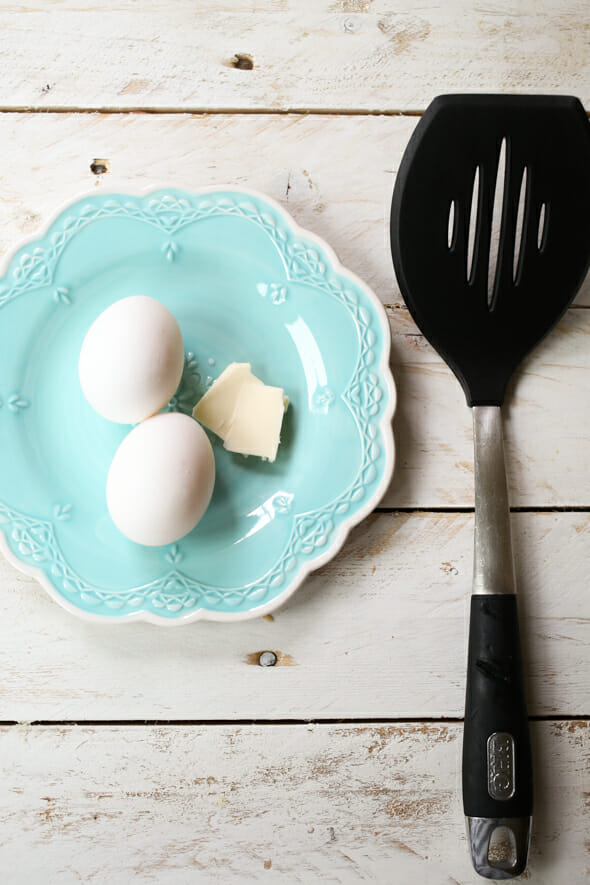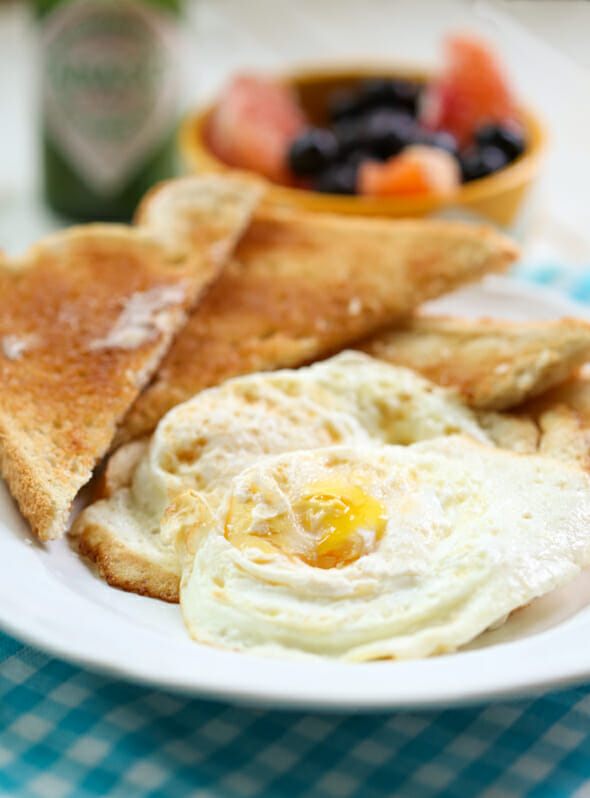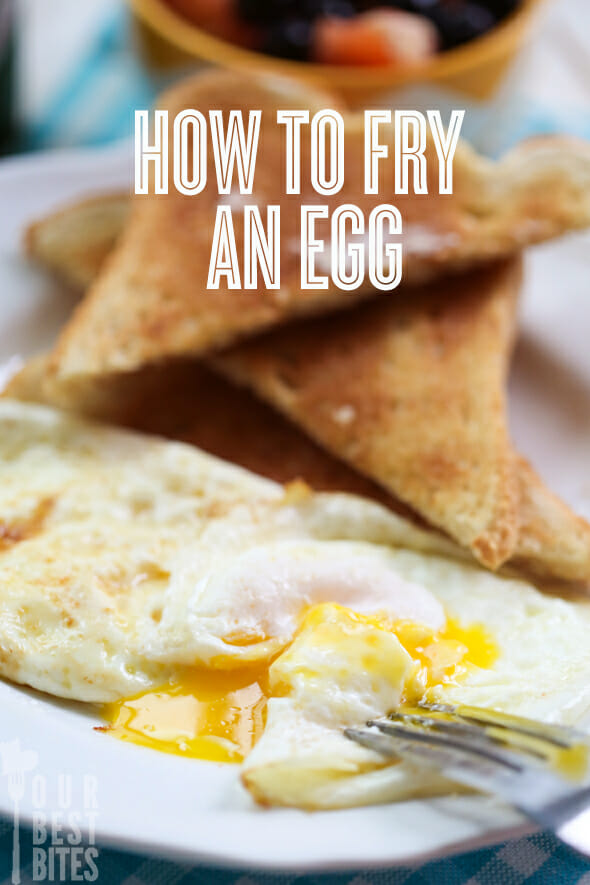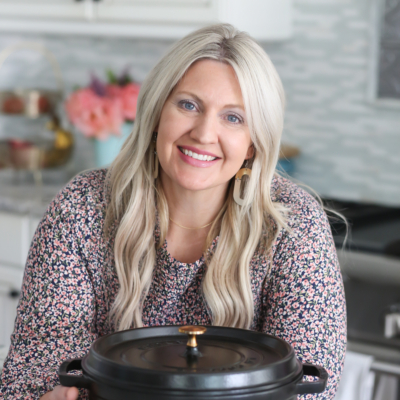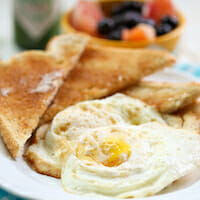
Eggs are kind of hard to ignore when it comes to healthy eating. It’s funny, because when I was growing up, they were kind of the forbidden fruit and now it’s hard to find any health or weight loss plan that doesn’t encourage eggs, at least in moderation (and sometimes not in moderation, depending on the plan.)
I’ve discussed at great length my complicated relationship with eggs. I’m sorry to go there again. For someone who usually hates eggs, I do realize that I write an awful lot about eggs. I should probably be evaluated.
But here’s the thing I’ve realized.
I like runny yolks. Like…a lot. I always thought I’d hate them because knowing the yolk wasn’t fully cooked eeked me out, but it turns out that is the only way that I consistently like eggs. Like, I could eat them a few times a week and be okay with it (unlike scrambled eggs where I usually can’t even make it through 2 scrambled eggs without my stomach turning.)
Making a good fried egg should be simple–I mean, it’s eggs, butter, a skillet, a spatula, and some salt and pepper (or green Tabasco sauce if you live in my house.)
But in light of my love affair with fried eggs, I set out to make the perfect fried egg. Here is what I was after:
1) Fully-cooked white. No sliminess. Anywhere. Also, I really like the crispy white parts around the edges.
2) Yolk cooked long enough to be firm-ish but still runny.
3) A million dollars and to be able to fit into my jeans from high school. Kidding. Kind of.
Of course, everyone likes their eggs fried a little differently–some like them sunny side up, which means they’re not getting flipped at all (and thus potentially slimy), some people don’t like the crispy white edges, some people want the yolk totally solid. Which is all totally possible here–if you like ’em sunny side up, don’t flip them. If you want the yolk solid, cook the egg a little longer after you flip it. I’m just going to share a few tips I found along the way to make things a little easier.
1. Use a bigger pan than you think you’ll need. Or, even better, an electric skillet. I know, I know, you have visions of the perfect little round eggs and think it’s going to happen in that tiny skillet you got in your wedding pots and pans. I can tell you from a lot of first-hand experience that it’s not. I tried. And tried and tried. Unless you’re an expert at flipping your eggs (and if so, kudos to you, and also, I hate you. Kidding. But watch yourself), you’re not going to be able to get a spatula in there to flip your eggs (or safely remove them from the pan.) So bring out the big guns–it’s worth it, I promise. And if you want your perfect eggs, you can always use egg or pancake molds (this is just an example–there are lots of different options and shapes!)
2. Use a thin, wide spatula. You’re dealing with something very delicate and want to disturb it as little as possible. I have a very thin silicone spatula that I use for stuff like this, but I really want this one.
3. Try not to let your eggs touch while they’re cooking. Unless you have a huge spatula, you’re going to have to try and flip them at the same time and let’s just say I’m not that coordinated. You can also cut them apart before you flip them, but then they’re not as cute. Because the cuteness of the eggs is of utmost importance.
4. It’s all about cooking the white. The area where I ran into the most trouble was trying to cook the egg evenly on both sides, which led to broken yolks and under-cooked whites. Then I had this epiphany to cook the egg almost completely on one side, flipping only to cook the very most top layer of the white. You do have to worry about over-cooked yolks this way, but that’s pretty easy to avoid if you’re careful.
Okay, are you ready? Heat a non-stick skillet to heat set to just a little above medium. When you can hold your hand about 2 inches from the surface and tell that it’s very hot, add 1/2-1 teaspoon of butter per egg (1/2 if you’re watching your butter intake; 1 ends up being quite a bit. And yes, butter–I’ve been losing weight using butter on my eggs! Non-stick cooking spray has its place, but not here…), melt the butter, and spread it into a circle about 6″ in diameter.
Carefully crack a cold egg into each melted butter circle (cold eggs will spread less; fresh ones will, too, but hopefully your eggs are reasonably fresh). It will start cooking immediately from the outside in. Sprinkle each egg with a small pinch of salt. Cook for about 2-3 minutes, watching the whites carefully–the area around the yolk will become more solid and opaque and if you gently poke the yolk, it will bounce back and won’t feel as fragile as a raw yolk will.
Once the “thickest” part of the white is almost completely cooked, gently jiggle a thin spatula under the egg and quickly flip it. Cook for about 1 more minute and then quickly remove the egg from the pan and serve it immediately (the yolk will continue to cook for a little while after you remove it from the pan, so if you’re after the runny yolk, be quick!) I serve mine with another tiny sprinkling of salt and a few shakes of green Tabasco sauce.
Serve it with some fruit and a piece or two of whole grain toast for a breakfast that will fuel you all morning!
And if you’re looking for some other ways to use them, try our Huevos Rancheros or Eggs on Toast with Creamy Spinach Sauce!
How to Make the Perfect Fried Egg
Tutorial by Our Best Bites
Heat a non-stick skillet to heat set to just a little above medium. When you can hold your hand about 2 inches from the surface and tell that it’s very hot, add 1/2-1 teaspoon of butter per egg (1/2 if you’re watching your butter intake; 1 ends up being quite a bit), melt the butter, and spread it into a circle about 6″ in diameter.
Carefully crack a cold egg into each melted butter circle (cold eggs will spread less; fresh ones will, too, but hopefully your eggs are reasonably fresh). It will start cooking immediately from the outside in. Sprinkle each egg with a small pinch of salt. Cook for about 2-3 minutes, watching the whites carefully–the area around the yolk will become more solid and opaque and if you gently poke the yolk, it will bounce back and won’t feel as fragile as a raw yolk will.
Once the “thickest” part of the white is almost completely cooked, gently jiggle a thin spatula under the egg and quickly flip it. Cook for about 1 more minute and then quickly remove the egg from the pan and serve it immediately (the yolk will continue to cook for a little while after you remove it from the pan, so if you’re after the runny yolk, be quick!) I serve mine with another tiny sprinkling of salt and a few shakes of green Tabasco sauce.
